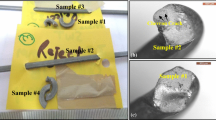Abstract
Spring steel is a name given to a wide range of steels used in the manufacture of springs, prominently in automotive and industrial suspension applications. High carbon of HC82BCr grade steel is drawn in the range of 4.0–3.0 mm as per customer’s requirement for production of spring mainly in automobile components. This spring steel grade is produced from continuous cast billet of size 150 mm × 150 mm and then hot rolled into the size of 5.5 mm diameter wire rod. Quality aspects of these spring are significant as any inherent abnormality in the material could lead to unwanted productivity losses or quality claims or sometimes serious safety issues. In this present study, spring samples broken during coiling stage were collected from plants for understanding their quality aspect and potential causes of breakage during production. Detailed microstructural investigation revealed that the root cause of breakage of the spring is related to the segregation of phosphorous and chromium in the billet which leads to the formation of martensite (brittle and less ductile) in wire rod during rolling process. This volume change due to formation of martensite increases the stress level at the interface of pearlite and martensite. During wire drawing, this increased stress level causes formation of internal crack in subsequent passes causing breakage during spring formation.







Similar content being viewed by others
References
S. Das, S. Talukdar, G. Mukhopadhyay, S. Bhattacharyya, Breakage of electrode grade steel wires during manufacturing: a metallurgical investigation. Eng. Fail. Anal. 95, 199–205 (2019)
Z. Huang, Y. Wang, Y. Xiong, Study of the microstructure and properties of ER70S-6 wire rods. J. Iron Steel Res. 17(S1), 929–932 (2011)
S. Das, J. Mathur, T. Bhattacharyya, S. Bhattacharyya, Failure analysis of steel wire of grade LRPC during drawing process. Eng. Fail. Anal. 27, 333–339 (2013)
S. Das, J. Mathur, T. Bhattacharyya, S. Bhattacharyya, Metallurgical investigation of different causes of center bursting led to wire breakage during production. Case Study Eng. Fail. Anal. 1, 32–36 (2013)
S. Das, P. Koli, J. Mathur, A. Dey, T. Bhattacharyya et al., Failure analysis of motor tyre bead wires during torsion test. Eng. Fail. Anal. Prev. 13, 684–688 (2013)
R.D. Barer, B.F. Peters, Wire Ropes, Why Metals Fail (Corden & Breach, New York, 1982), pp. 218–223
G.A. Sharp, Steel wire for ropes, in Steel Wire Handbook, vol. 3, ed. by A.B. Dove (The Wire Association Inc., Branford, 1972), pp. 77–94
J.R. Davis, Wear resistance of steels, in ASM Specialty Handbook: Carbon and Alloy Steels, ed. by J.R. Davis (ASM International, Phildelphia, 1996), pp. 170–200
F.L. Jamieson, Failures of lifting equipment, in Failure Analysis and Prevention, ASM handbook, Vol. 11, 9th edn., ed. by K. Mills, J.R. Davis, J.D. Destefani, D.A. Dietrich, G.M. Crankovic, H.J. Frissell (American Society for Metals, Philadelphia, 1986), pp. 514–521
S.K. Dhua, A. Ray, S. Jha, Metallurgical investigation of locked coil wire rope samples fractured during service. Steel India 23(2), 40–42 (2000)
A. Ray, S.K. Dhua, K.B. Mishra, S. Jha, Microstructural manifestation of fractured Z-profile steel wires on the outer layer of a failed locked coil wire rope. J. Fail. Anal. Prev. 3(4), 33–37 (2003)
Z. Zimerman, H. Darlington, E.H. Kottcamp, Jr., Selection of operating parameters to prevent central bursting defects during cold extrusion. J. Met. Form. 50, 47–62 (1971)
B.D. Clarke, I.B. Mclvor, Effect of phosphorus on microstructure and strength of high carbon steel rod. Iron Steel Mak. 16, 335–344 (1989)
S.K. Choudhary, A. Ghosh, A study of morphology and macro segregation in continuously cast steel billets. Iron Steel Inst. Jpn. Int. 34, 338–345 (1994)
J.K. Brimacombe, The challenge of quality in continuous casting processes. Metall. Mater. Trans. B 30B, 553 (1999)
A. Ghosh, Segregation in cast products. Sadhana 26, 5–24 (2001)
H. Combeau, M. Zaloznik, S. Hans, P. Richy, Prediction of macrosegregation in steel ingots: influence of the motion and the morphology of equiaxed grains. Metall. Mater. Trans. B 40B, 289–304 (2009)
M.C. Flemings, Modeling of casting, in Welding and Advanced Solidification Processes-VIII, ed. by B.G. Thomas, C. Beckermann (TMS, Warrendale, 1998), p. 1
Author information
Authors and Affiliations
Corresponding author
Additional information
Publisher's Note
Springer Nature remains neutral with regard to jurisdictional claims in published maps and institutional affiliations.
Rights and permissions
About this article
Cite this article
Das, S., Talukdar, S., Solanki, V. et al. Breakage of Spring Steel During Manufacturing: A Metallurgical Investigation. J Fail. Anal. and Preven. 20, 1462–1469 (2020). https://doi.org/10.1007/s11668-020-00993-9
Received:
Accepted:
Published:
Issue Date:
DOI: https://doi.org/10.1007/s11668-020-00993-9




